




Part 1-Beaks
For the purposes of this lesson, birds are divided into five categories based on the shape of their beaks and feet. The shape of beaks and feet allows each kind of bird to feed in a particular habitat.
1. Marsh or Wading Birds-a marsh bird wades in the water, needs a long neck for fishing, long legs for wading, and a narrow, pointed bill for spearing its prey (fish, frogs, snakes)
2. Water or Swimming Birds-these birds squeeze water from the food (fish, plant material, etc.) they catch. Their wide bills hold the food while allowing water to drain from it. Their broad, webbed feet act like paddles and they are good swimmers.
3. Seed-eating Birds-a seed eating bird has a bill that is strong and thick for cracking seeds, a short neck, and perching feet.
4. Insect-eating Birds-an insect-eating bird has a thin, pointed bill, a short neck, perching feet, and a broad tail.
5. Predator (hunting) Birds-this kind of bird has a curved beak for tearing meat, a short muscular neck, and feet with talons that are used to catch and hold prey.
Distribute Work Sheet 1 to the students and discuss the six listed types of beaks and the purposes of each. Have the students match the six types of beaks to the beaks pictured on the worksheet. Next, have the students answer questions 1-6 on the worksheet.
Part II-Feet
Distribute Work Sheet 2 to the students and discuss the six types of feet that are included on the worksheet. Have the students match the the six types of feet to the feet pictured on the worksheet. Next, have the students answer questions 1-8 on the worksheet.
Part III-Build a Bird
In preparation for this activity, review with your students how the shape of beaks and feet make it possible for different kinds of birds to adapt to different habitats.
Next, distribute the Build a Bird instruction sheet and cut out pages. Review the instructions with students. When the students have completed "building their bird",ask them to describe each bird's characteristics, and help them to find proper names for each bird (use a reference book like The Audubon Society Field Guide to North American Birds for guidance)
Evaluation:
Check each students completed bird for accuracy. Students should demonstrate through discussion of their bird their understanding of beak and feet adaptation.
Follow-Up:
1. An interested student may do research on an animal other than a bird. Be sure to have him/her note whether the kind of feet an animal has enables it to secure food. For example, investigate a beaver's feet or the feet of a Pine Barrens Tree Frog.
2. Students may create birds that have beaks and feet that do not fit together. Students should be able to explain why their "Frankenstein Birds" could not survive (or perhaps explain how they think the bird might be able to survive).
3. Teachers may make a bulletin board and display student birds. A separate display might be devoted to the "Frankenstein Birds"
4. Students who want to observe birds in their community may keep a list of different birds sighted. This list may be presented to the class.

This lesson will introduce the students to the following vocabulary words:(Click on a word to see its definition-use your browser's BACK button to return to this page)

Science standards:
5.1-All students will learn to identify systems of interacting components and understand how their interactions combine to produce the overall behavior of the system.
5.6-All students will gain an understanding of the structure, characteristics, and basic needs of organisms.
5.7-All students will investigate the diversity of life.
5.12-All students will develop an understanding of the environment as a system of interdependent components affected by human activity and natural phenomena.
Evaluate our site! Click on the Grade Page icon to go to our evaluation page. Won't you please take a minute to tell us how we can better help you bring the Pinelands into your classroom

